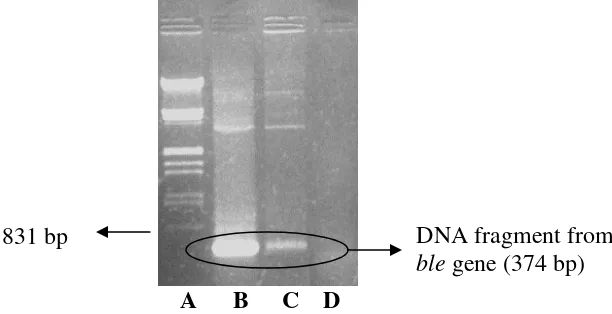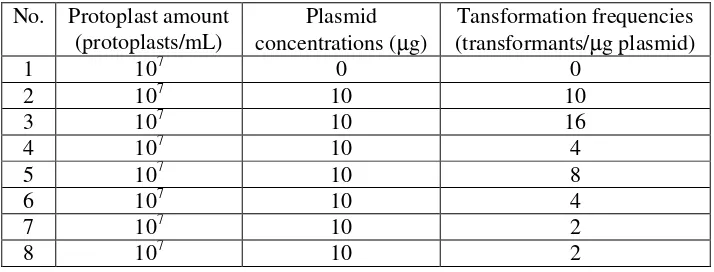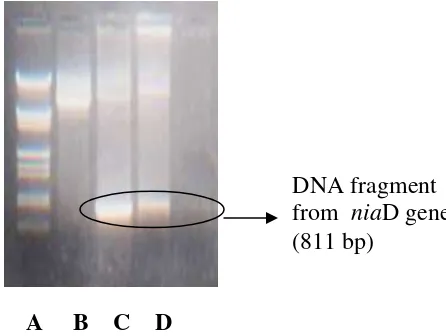A COMPARATIVE STUDY ON THE TRANSFORMATION OF MONASCUS PURPUREUS ALBINO’S MUTANT USING TWO DIFFERENT SELECTION
MARKERS
Tiana Milanda1, Marlia S. Wibowo2, Tutus Gusdinar2, Haryanto Dhanutirto2, Triyani Sumiati2, Dudi Hardianto3
1
Department of Pharmacy, FMIPA, UNPAD, Jatinangor
2
School of Pharmacy, ITB, Bandung
3
Biotechnology Center, PUSPIPTEK, Serpong
ABSTRACT
A comparative study on the transformation of Monascus purpureus albino’s mutant was carried out using two different selection markers, phleomycin resistance gene and the nitrate reductase gene, by polyethyleneglycol-mediated protoplast transformation. The first marker is based on the presence of genes conffering resistance to phleomycin (ble gene). The other marker, the nitrate reductase gene (niaD) from Aspergillus nidulans, utilize the conversion of an auxotroph of nitrate reductase from the albino’s mutant to prototrophy. The efficiency of transformation using ble gene (31-45 transformants/µg plasmid) was higher than the niaD gene (2-16 transformants/µg plasmid). Mytotic stability studies demonstrated that all transformants were stabile up to 5 generations. The presence of the ble gene and the niaD gene in the transformants genome were analysed by PCR. These transformation systems are the first essential step in the cloning of the citrinin (a mycotoxin) biosynthetic genes. They provide the tools to prevent citrinin contamination in the other of Monascus metabolites, like azaphilone pigments and monascidin K (an antihypercholesterolemia agent), which used in human food and drugs.
Key words : Monascus purpureus, albino’s mutant, phleomycin, nitrate reductase, ble, niaD, transformation.
Introduction
Monascus purpureus is filamentous ascomycetes that form asexual uninucleate
spores. They are well known producers of natural pigments which have been widely used
for hundreds of years in the Far East as food colorants for rice (angkak), processed meats
and wine or in Chinese medicine (Hiroi et al., 1979; Jacobson and Wasileski, 1994).
Their relatively high stability with respect to pH and temperature, are interesting features
which favour their use as substitutes for synthetic food colorants. Moreover, M.
purpureus produces statins (such as lovastatin), with 3-hydroxymethylglutaryl-CoA
As a part of the investigation on this fungal pigments, an antibacterial compound
monascidin A, have been isolated from supernatant cultures. But, Blanc et al. (1995) have
characterized this antibiotic as citrinin, a theratogenic and nephrotoxic agent. It is
essential that the Monascus products avoid the occurrence of this mycotoxin.
According to last study, production of citrinin can be avoided by detoxification of
the pigments, the use of non producing citrinin strains or fermentative conditions of non
production citrinin. But there are no effective control producers for preventing
contamination of citrinin, because the three metabolites are produced by Monascus
through the same polyketides pathways (Blanc et al, 1998). Only little is known about
this biochemical pathways in Monascus, due to a lack of knowledge of the genes
involved. The number of chromosomes, the genome size and the possibility of the
transforming this fungi with exogenous DNA are unknown too. This basic information is
essential to start any molecular study on the genes involved in pigment, lovastatin or
citrinin production by M. purpureus (S. Campoy et al., 2003).
Introduction of DNA in different filamentous fungi has been achieved by
polyethyleneglycol-mediated protoplast transformation (Cantoral et al., 1987; Punt et al.,
1987). Transformants strains can be selected by the use of dominant selectable markers
or by the positive screening of auxotrophic mutants for a defined gene. Recently, reports
of filamentous fungal transformation using dominant resistance genes, such as
hygromycine or phleomycin resistance have appeared (M.J. Daboussi et al., 1989). An
alternative approach has been achieved in different filamentous fungi using nitrate
reductase deficient mutants (niaD) selected through their resistance to chlorate (Maladier
et al., 1989).
In this work, we report on a comparative study of the transformation of M.
purpureus with different exogenous plasmid DNA by protoplast transformation. These
vectors are based in presence of genes coffering resistance to phleomycin or based in the
complementation of niaD mutant. These transformation systems are the first essential
step in the cloning of the citrinin biosynthetic genes. Once a gene involved in citrinin
biosynthesis is clearly characterized, such gene will be disrupted in order to obtain
citrinin negative genetically designed strains. There is an effective control producers for
Materials and methods
Strains and culture conditions
M. purpureus ITBCC-HD-F002, a strain non producing pigments (albino) and
lovastatin, was obtained by ethyl methanesulphonate (EMS) mutagenesis from the natural
isolate, M. purpureus ITBCC-HD-F001. This mutant was routinely grown in solid YMP
medium (0.3 % yeast extract, 0.3 % malt extract, 0.6 % peptone, 2.0 % glucose and 1.5 %
bacto-agar) for 7-10 days at 28°C. Spores from several plates of solid YMP medium were
collected using sterile saline. The spores were used to inoculate liquid cultures (in liquid
YMP medium).
Plasmids
The plasmids used in this study were :
1. pULJL43 (4.6 kb), an integrative plasmid in Penicillium chrysogenum containing the
phleomycin resistance gene (ble) from Streptoalloteichus hindustanus expressed
using the pcbC promoter and the CYC1 terminator from Saccharomyces cerevisiae at
the 3’ end of the ble gene (kindly provided by S. Campoy, Instituto de Biotecnologia
de Leon, Spain).
2. pSTA14 (7 kb), an integrative plasmid containing the nitrate reductase gene (niaD)
from Aspergillus nidulans (kindly provided by S.S. Sandhu, Departement of
Biological Science, Rani Durgawati University, India).
Determination of phleomycin minimum inhibitory concentration (MIC)
Growth inhibition of M. purpureus ITBCC-HD-F002 was tested by plating 105
spores on solid YMP medium supplemented with phleomycin in different concentrations,
i.e. 0, 0.5, 1.0, 1.5, 2.0, and 2.5 µg/mL The resulting plates were incubated at 28°C for
7-14 days.
Mutagenesis M. purpureus ITBCC-HD-F002 with ethyl methanesulphonate (EMS) and chlorate
Liquid YMP medium (50 mL) was inoculated with 105 spores/mL of M. purpureus
mL of cultures was concentrated by centrifugation (10.000 x g, 10 min, at 4°C) and
resuspended in 10 mL stabilizing buffer (0.2 M phosphate buffer pH 7.0). One mL of this
suspension was incubated in a solution containing 100 µ L 2 % glucose, 850 µ L
stabilizing buffer and 50 µ L EMS at 28°C for 90 min on rotary shaker at 150 rpm. The
treatment was stopped by the addition of 2 mL 5 % sodium thiosulphate and incubated
for 20 min at 28°C on rotary shaker at 150 rpm. The suspension was concentrated by
centrifugation (10.000 x g, 10 min, at 4°C) and resuspended in 1 mL stabilizing buffer.
EMS mutants were grown on minimal medium/MM (2.5 % potato dextrose agar,
5% glucose, 0.15 % NaCl, 0.1 % MgSO4 and 0.25 % KH2PO4) supplemented by various
concentration of KClO3 (0.1, 0.2, 0.3, 0.4 and 0.5 mM) and 5 mM urea. These plates
were incubated at 28oC for 7-14 days.
Chlorate-resistant mutants were selected to different classes on the basis of their
growth on MM containing one of the four following nitrogen sources : 23 mM NaNO3,
10 mM NaNO2, 5 mM ammonium tartrat and 0,7 mM glutamate). All cultures were
maintained at 28°C for 7-14 days. The niaD mutants were grown on all nitrogen source,
except nitrate.
Protoplast preparation and transformation process
The transformation procedure applied is based on the protocol described by Herzog
et al. (1996), with several modifications. About 50 mL of liquid YMP medium
(pULJL43) was inoculated with 105 spores/mL (from M. purpureus ITBCC-HD-F002
and for niaD mutant, respectively) and incubated for 20 h at 28°C on rotary shaker at 150
rpm. The resulting mycelium was filtered through Whatman No.1 filter paper, washed
twice with 0.6 M KCl and resuspended in 20 mL 0.6 M KCl including the lytic enzyme.
The following lytic enzymes were tested to obtain protoplasts : (1) lysing enzyme from
Trichoderma harzianum (Sigma-Aldrich) at 5 mg/mL (2) a mixture of lysing enzyme
from T. harzianum (Sigma-Aldrich) at 5 mg/mL and cellulase (Sigma-Aldrich) at 10
mg/mL (3) a mixture of glucanex (Sigma-Aldrich), cellulase (Sigma-Aldrich), and
maserozyme (Sigma-Aldrich) at 10 mg/mL, respectively. The suspension was incubated
at 28°C with orbital shaking (100 rpm) and protoplast formation was followed under the
paper, concentrated by centrifugation (3,000 g, 20 min), and washed twice with 50 mM
CaCl2.
In transformation experiments, 100 µL aliquots of protoplast suspensions (107
protoplast/mL) was mixed with 10 µg plasmid DNA followed by the addition of 50 µ L
PEG solution (60 % PEG 6000, 10 mM Tris-HCl pH 7.5, 50 mM CaCl2). After 20 min
incubation on ice, 1 mL PEG solution was added. Following 15 min further incubation at
room temperature, aliquots were poured onto solid YMP medium including 5 µg/mL
phleomycin (for pULJL43) or selection medium (MM supplemented with 23 mM
NaNO3) (for pSTA14) The resulting plates were incubated at 28°C. The first
transformants were visible after 3-7 days. After 7 days (for pULJL43) or 14 days (for
pSTA14), the total number of transformants was determined and colonies selected for
further studies were transferred to fresh plates. The stability of the mutant was tested in
YMP medium including 5 µg/mL phleomycin (for pULJL43) or selection medium (for
pSTA14) until fifth generations.
DNA isolation and amplification
DNA was extracted from the transformants by Wizard Genomic DNA Purification
Kit (Promega). PCR analysis for detection of ble gene in putative transformants was
performed using primer pairbleF (5’-AAGTTGACCAGTGCCGTTCC-3’) and bleR
(5-GTCGGTCAGTCCTGCTCCTC-3’), which amplified 373 bp DNA fragment of ble
gene. PCR amplification included an initial denaturating step of 3 min at 94°C (hot start),
followed by 30 cycles of 1 min denaturation (94°C), 1 min annealing (56°C) and 1 min
polymerization (72°C).
PCR analysis for detection of niaD gene in putative transformants was performed
using primer pair niaDF (5’GGAGGGCGAGTGTCAAGT3’) and niaDR
(5’GCCCCAGTTCCCATTCGTC3’), which amplified 811 bp DNA fragment of niaD
gene. PCR amplification included an initial denaturating step of 3 min at 94°C, followed
by 30 cycles of 1 min denaturation (94°C), 1 min annealing (56°C) and 1.5 min
Results and discussion
The transformation of M. purpureus ITBCC-HD-F002 protoplast with pULJL43 plasmid
In order to optimize the formation of protoplasts from M. purpureus
ITBCC-HD-F002, mycelia treated with lysing enzyme from T. harzianum yielded about 2.89 X 107
protoplast/mL. With lysing enzyme and cellulase, the protoplasts yield increased to 1.01
X 108 protoplasts/mL The best yield (9.8 X 108 protoplasts/mL) was reached with
glucanex, cellulase and maserozyme. The improved protoplast yield with glucanex and
masrozyme suggests that the cell wall structure of M. purpureus may have a complex
polymer in addition to glucan that is resistant to the T. harzianum lytic enzyme.
M. purpureus ITBCC-HD-F002 is very sensitive to phleomycin, being unable to
grow in plates supplemented with 1 µg phleomycin/mL. This protoplast are about 2.5
fold more sensitive to phleomycin than the other M. purpureus (S. Campoy et al., 2003).
This was considered suitable for the selection of resistant colonies in transformation
experiments.
Transformation experiments were performed with 107 protoplasts and 10 µg of
plasmid DNA. The transformation resulted in a good transformation system in which
31-45 transformants /µg plasmid were obtained (Table 1).
Table 1. The Transformation Results of M. purpureus ITBCC-HD-F002 Protoplast with pULJL43 Plasmid
No. Protoplast amount (protoplast/mL)
Plasmid concentrations (µg)
Tansformation frequencies (transformants/µg plasmid)
1 107 0 0
2 107 10 40
3 107 10 31
4 107 10 45
The stability of the transformants was tested in solid YMP medium supplemented
with 5 µg phleomycin /mL. About 50 transformants pULJL43 of M. purpureus
ITBCC-HD-F001 were submitted to five rounds of replication and 100 % of them retained the
A B C D E
Figure 1. The stability test results of pULJL43 transformants from M. purpureus ITBCC-HD-F002 : A. First generations; B. Second generations
C. Third generations; D. Fourth generations; E. Fifth generations
PCR analyses targeted at the ble gene yielded of the expected size DNA fragment
(373 bp) in transformants (Figure 2)
A B C D
Figure 2. PCR detection of the ble gene from pULJL43 transformants M. purpureus ITBCC-HD-F002 : A. DNA marker λ/HindIII/EcoRI; B. DNA of pULJL43 plasmid (positive control); C. DNA of pULJL43 transformants from
M. purpureus ITBCC-HD-F002; D. DNAof M. purpureus ITBCC-HD-F002 (negative control)
The transformation of niaD mutant protoplasts from M. purpureus ITBCC-HD-F002 with pSTA14 plasmid
Since nitrate reductase deficient mutants can be selected on the basis of their
resistance to chlorate, we tested M. purpureus for its sensitivity to chlorate. Generally,
niaD mutants of fungi are selected by spontaneous mutations on appropriate MM
supplemented with various concentration of KClO3 and a nitrogen source (Dabousi et al,
1989). But, it has been observed that niaD mutants isolated simply by spontaneous
mutation on chlorate were not stable (S.S. Sandhu et al, 1991). We developed to isolate
stable niaD mutants of M. purpureus by treating mycelium with EMS and chlorate.
After mutagenesis by EMS (2.5%, 90 min) and 0.4-0.5 mM chlorate, we obtained
11 chlorate resistance mutants. The selected mutants were transferred to MM containing
nitrate as the sole nitrogen source. Two were found to be nii mutant, while one was niaD
mutant.
In typical experiment approximately 107 protoplast were mixed with 10 µg of
plasmids pSTA14. The protoplast were plated on a medium containing nitrate as the sole
nitrogen source. The controls, protoplast incubated with aquades, produced no
transformant. Growing colonies with aerial mycelium were obtained for 7-14 days after
plating : 10 µg of plasmids pSTA14 produced transformation frequencies that ranged
from 2-16 transformants/µg DNA (Table 2).
Table 2. The Transformation Results of niaD Mutant Protoplast from M. purpureus ITBCC-HD-F002 with pSTA14 Plasmid
No. Protoplast amount (protoplasts/mL)
Plasmid concentrations (µg)
Tansformation frequencies (transformants/µg plasmid)
1 107 0 0
2 107 10 10
3 107 10 16
4 107 10 4
5 107 10 8
6 107 10 4
7 107 10 2
8 107 10 2
Stable transformants were recovered until fifth generation in selection medium
Figure 3. The stability test results of pSTA14 transformants from M. purpureus ITBCC-HD-F002 : A. First generations; B. Second generations;C. Third generations;D. Fourth generations; E. Fifth generations
PCR analyses targeted at the niD gene yielded of the expected size DNA fragment
(811 bp) in transformants (Figure 4)
A B C D
Figure 4. PCR detection of the niaD gene from pSTA14 transformants from
M. purpureus ITBCC-HD-F002 : A. DNA marker λ/HindIII/EcoRI; B. DNA of niaD mutant from M. purpureus ITBCC-HD-F002 (negative control); C. DNA of pSTA14 plasmid (positive control); D. DNA of pSTA14 transformants from M. purpureus ITBCC-HD-F002
A comparative study on the transformation of M. purpureus ITBCC-HD-F002 using two different selection markers
Comparison of protoplast transformation using this two different selection markers
in M. purpureus ITBCC-HD-F002 was made. The efficiency of transformation with
genes coffering resistance to phleomycin was higher than the transformation based in the DNA fragment
from niaD gene (811 bp)
complementation of niaD mutant, which makes the former system ideal to transform M.
purpureus ITBCC-HD-F002 due its simplicity.
Acknowledgments
This work was supported by Hibah Penelitian Tim Pascasarjana (HPTP) II,
2004-2006 from Proyek Pengkajian dan Penelitian Ilmu Pengetahuan dan Teknologi,
Direktorat Jenderal Pendidikan Tinggi, Departemen Pendidikan Nasional. We thank S.
Campoy and S.S. Sandhu for providing the plasmids.
References
1. Blanc, PJ, H. Hajjaj, MO. Loret, and G. Goma (1998) Control of Production of Citrinin by Monascus, The Symposium on Monascus Culture and Applications, Toulouse, France.
2. Blanc, PJ., MO. Loret, and G. Goma (1998) Pigments and Citrinin Production during Cultures of Monascus in Liquid and Solid Media, In Advance in Solid State Fermentation, Toulose, France, 393-406.
3. Blanc, PJ., MO. Loret, and G. Goma (1995) Production of Citrinin by Various Species of Monascus, Biotech. Let., 17(7), 291-294.
4. Campoy, S., F. Perez, JF. Martin, S. Gutierrez, P. Liras (2003) Stable Transformants of M. purpureus obtained by Protoplast Transformation and Agrobacterium-mediated DNA Transfer, Cur. Genet., 43 : 447-452.
5. Cantoral, JM, B. Diez, JL. Barredo, E. Alvarez and JF. Martin (1987) High Frequency Transformation of Penicillium chrysogenum, Bio/Technology, 5:494-497.
6. Daboussi, MJ., JA. Djeballi, C. Gerlinger, PS. Blaiseau, I. Bouvier, M. Cassan, MH. Lebrun, D. Parisot, and Y. Brygoo (1989) Transformation of Seven Species of Filamentous Fungi Using The Nitrate Reductase Gene of Aspergillus nidulans, J.Curr. Genes, 15, 1989, 453-456.
7. Endo, A. (1985) Compactin (ML-236B) and Related Compounds as Potential Cholesterol-lowering Agent that Inhibit HMG-CoA Reductase, J. Med. Chem., 28 , 401-405.
9. Herzog, RW., H. Daniell, NK. Singh, and PA. Lemke (1996) A Comparative Study on The Transformation of Aspergillus nidulans by Microprojectile Bombardment of Conidia and a More Conventional Procedure Using Protoplast Treated with Polyethylenglycol, J. Appl. Microbiol. Biotechnol., 45, 333-337.
10.Jacobson, G., J. Wasileski (1994) Production of Food Colorants by Fermentation, In : A. Gabelmen (ed) Bioprocess of Production Flavour, Fragrance and Color Ingredients, Wiley Interscience, New York, pp. 205-237.
11.Malardier, L., MJ. Daboussi, J. Julien, F. Roussel, C. Scazzocchio, and Y. Brygoo, (1989) Cloning of The Nitrate Reductase Gene (niaD) of Aspergillus nidulans and Its Use for Transformation of Fusarium oxysporum, J. Gene, 78(1), 1989, 147-156.
12.Punt, PJ., RP. Oliver, MA Dingemanse, MA Pouwels, CAMJJ van del Hondel (1987) Transformation in Aspergillus based on The Hygromicin B Resistance Marker from E. coli, Gene, 56, 117-124.



